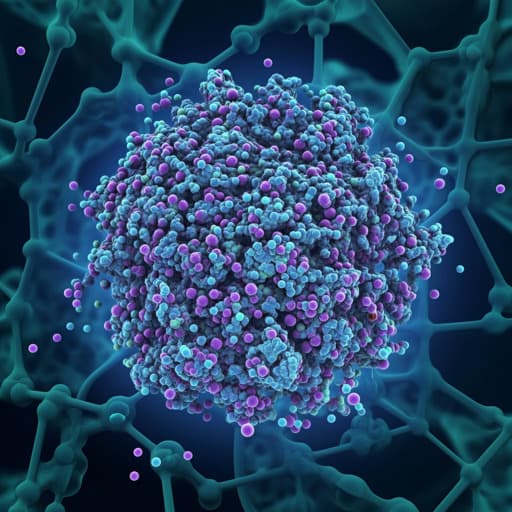
Engineering and Technology
Using visible light to activate antiviral and antimicrobial properties of TiO2 nanoparticles in paints and coatings: focus on new developments for frequent-touch surfaces in hospitals
M. Schutte-smith, E. Erasmus, et al.
Recent advancements by M Schutte-Smith, E Erasmus, R Mogale, N Marogoa, A Jayiya, and H G Visser have revealed exciting possibilities in using visible light to enhance the antiviral and antimicrobial properties of TiO2 nanoparticles in paints and coatings. This innovative approach aims to combat the spread of infectious diseases on frequently touched surfaces in critical environments like hospitals.
~3 min • Beginner • English
Introduction
The paper addresses the urgent need to reduce healthcare-associated infections by preventing microbial and viral persistence and transmission from frequently touched surfaces. It frames the problem by summarizing how bacteria, fungi, and viruses adhere to and survive on diverse surfaces, the role of polymicrobial biofilms, and the shortcomings of conventional disinfection given antimicrobial resistance. The purpose is to review recent advances that enable TiO2-based paints and coatings to be activated by visible/indoor light to generate reactive oxygen species (ROS) for continuous antimicrobial/antiviral action on indoor, high-touch surfaces (e.g., door handles, bed rails, keyboards) in hospitals and food-processing environments. The review underscores the importance of shifting TiO2 activity from UV-only to visible light via doping and composite strategies, while also considering durability, safety (leaching), and real-world performance.
Literature Review
This review synthesizes recent literature on: (1) surface contamination pathways, biofilm formation, and persistence of pathogens; (2) mechanisms of TiO2 photocatalytic disinfection via ROS generation and influencing factors (band gap, recombination, facets, surface area, morphology); (3) strategies to achieve visible-light activation of TiO2, including metal dopants (e.g., V, Mo, Mn, Cu, Ag, Au, Pt, Pd; rare earths), non-metal dopants (e.g., N, S, P, carbon), carbon quantum dots/carbon dots sensitization, and composites with graphene/g-C3N4; (4) facet engineering and morphology control to enhance charge separation and surface reactivity; (5) application-specific formulations in paints/coatings (binders, hydrophilic/hydrophobic balance, durability, NOx abatement with minimized NO2 formation), thin films, and aerosol-deposited coatings; (6) integration on textiles and flexible substrates (cotton, non-woven fabrics, polyester blends) with approaches to improve adhesion and wash durability (e.g., sonosynthesis/sono-fabrication, PDMS, GO interfaces); (7) antimicrobial/antiviral performance under visible/ambient light across diverse organisms (E. coli, S. aureus, L. pneumophila, fungi, and surrogate viruses), including dark activity in some formulations; and (8) environmentally friendly phytosynthetic routes to TiO2-based nanostructures for sustainable production.
Methodology
This is a narrative review that compiles and analyzes recent advancements on visible-light-activated TiO2 nanoparticles for antimicrobial/antiviral paints and coatings, with emphasis on indoor/frequent-touch applications. The paper does not report a systematic review protocol; instead, it summarizes representative studies spanning: (a) synthesis and doping methods (sol-gel, hydrothermal/solvothermal, calcination, aerosol flame synthesis and thermophoretic deposition, electrospinning, anodization, microbial/phyto-synthesis, pp-MOCVD, spin coating, dip-pen/soft lithography, sonochemical approaches); (b) material designs (metal and non-metal doping; plasmonic embedding of Ag/Au; carbon dots/CQDs; graphene/g-C3N4 hybrids; core–shell structures; co-doping such as Cu–N, tourmaline–N; facet engineering; nanowires, nanotubes, hollow nanocubes); (c) coating/paint formulations (inorganic/organic binders, PDMS matrices, transparency requirements, durability, hydrophilicity/hydrophobicity tuning, NOx photocatalysis with minimized NO2); and (d) performance assessments under UV, visible, and ambient indoor light against chemical pollutants (NOx, acetaldehyde, dyes, VOCs) and microbes/viruses. It collates quantitative outcomes reported by the original studies (band gaps, degradation rates, log-reductions, durability cycles) to draw practice-oriented insights for hospital surfaces.
Key Findings
- Visible-light activation via doping/composites:
- Metal dopants: V-doped TiO2 reduced band gap from 3.25 eV to 2.34 eV and doubled visible-light photocatalysis vs pristine TiO2 in methylene blue reduction. Mn/graphene in TiO2 nanowires tuned anatase/rutile balance and oxygen vacancies; rutile at 800°C showed superior visible-light NOx reduction. Cu-doped TiO2 (0.5 mol% Cu) reduced band gap to ~2.8 eV and achieved 99.9999% bacterial inactivation (E. coli, S. aureus) within 30 min under visible light. Ni-doped TiO2 with Ag decoration enhanced visible-light inactivation of E. coli and fungi (≈2-log10 CFU mL−1 for F. graminearum in 3 h).
- Plasmonic noble metals: Ag- or Au-modified TiO2 enhanced visible activity via LSPR; Ag-modified samples showed strong antibacterial effects under visible light; Au-embedded TiO2 thin films remained transparent and photoactive in normal light, showing a red-shifted SPR band (to ~626 nm) and improved self-cleaning.
- Non-metal dopants: N-, S-, and P-doping narrowed band gaps (e.g., black/red phosphorus–TiO2 to ~2.5 eV) and improved visible-light photocatalysis; sulfur-doped TiO2 demonstrated visible-light bactericidal activity (e.g., M. lylae).
- Carbon-based sensitization: Carbon dots/CQDs on/within TiO2 suppressed e−/h+ recombination, markedly boosting visible-light degradation (e.g., mesoporous TiO2+CQDs removed 98% methylene blue vs 5% for pristine under identical conditions) and enabled repeated antibacterial cycles (>7 cycles).
- Graphene/g-C3N4 hybrids: N-doped TiO2 nanotubes with g-C3N4 achieved ~98% RhB degradation under solar light, retaining activity over multiple cycles; graphene served as an electron sink to prevent recombination, improving visible-light performance.
- Coatings/paints and NOx management:
- Mn-doped TiO2 paint under indoor visible light degraded NO up to 95% with only ~2% conversion to NO2, outperforming some commercial paints that reached up to 8% NO2 formation, highlighting the need to minimize harmful by-products.
- Carbon-doped TiO2 paints degraded acetaldehyde (indoor visible) and NOx (outdoor UV); higher dopant load maximized conversion, though optimal quantum efficiency occurred at lower dopant levels. Outdoor durability decreased over time due to surface oxidation products but could be restored by rinsing in some systems.
- Antiviral/antimicrobial efficacy under visible/ambient light:
- Ag–TiO2 sol–gel coatings (1 wt% Ag) achieved >99.99% (>4.17-log) viral reduction (influenza A, enterovirus) after 20 min UVA; visible-light activity also demonstrated. TiO2 retained virucidal activity on dried droplets and at high RH (85%) against HCoV-NL63.
- Tourmaline–N co-doped TiO2 (T-N-TiO2) expedited S. aureus inactivation vs N-TiO2 (1 hour faster), generating more •OH radicals (EPR evidence) under visible light; order of susceptibility: S. aureus < E. coli < M. avium < C. albicans.
- Ag@TiO2 incorporated into paint (1–5 wt% Ag) disinfected Gram-negative E. coli more effectively than Gram-positive S. aureus under visible light.
- Some nanostructured anatase–rutile–carbon coatings (pp-MOCVD) exhibited strong antimicrobial and antibiofilm effects under visible and ambient light, and even measurable dark activity (suggested mechanisms: zeta potential modification, hydrophilicity, desiccation), preventing biofilm growth.
- Textiles and flexible substrates:
- TiO2/SiO2/graphene oxide nanocomposites ultrasonically bonded to polyester–cotton showed visible-light self-cleaning (gentian violet removal in sunlight; methylene blue decomposition under visible light) and maintained performance after multiple washes; sonofabrication provided stronger adhesion than dip-coating.
- Mesoporous TiO2 hydrosols on non-woven and cotton fabrics showed virucidal activity under indoor light: ~90–99% reduction for HAdV-5 and MHV-3 on non-woven; ~90% for MHV-3 on cotton; performance retained after a wash (limited test conditions).
- Durability, hydrophobicity/hydrophilicity, and binders:
- Superhydrophobic WO3–TiO2/PDMS coatings maintained antifouling and self-cleaning on outdoor surfaces for ~450 days; activity restored by water flushing after initial cycles.
- Hydrophobic vs hydrophilic surfaces trade-offs: hydrophobic surfaces can deter adhesion; hydrophilic surfaces enhance contact and moisture trapping for ROS generation; inorganic binders can mitigate photodegradation of organic components.
- Green synthesis:
- Multiple phyto/microbial routes yielded anatase/rutile TiO2 and TiO2 composites (e.g., using lemongrass, Annona squamosa peel, Andrographis paniculata, neem, pomegranate rind), supporting sustainable production with reported antimicrobial and photocatalytic functionalities.
- Practical challenges and observations:
- Field trials showed significant reduction of microorganisms in hospital wards coated with Cu-doped TiO2 paint vs standard paint over one year.
- Some dopants (e.g., higher Cu loading) cause undesirable color changes (brown), impacting paint aesthetics; coatings can suffer activity loss outdoors over time due to environmental factors; binders may trap NPs and hinder ROS generation.
- Fluorinated TiO2 accelerated inactivation of surrogate noroviruses under low-level UVA from office fluorescent lights, yet may still require enhancing visible-light response for typical ambient conditions.
Discussion
The review demonstrates that tailoring TiO2 through doping (metal, non-metal), plasmonic enhancement, and carbon/graphene-based hybridization can lower the band gap, improve charge separation, and leverage surface/morphology control to achieve effective antimicrobial and antiviral action under visible and ambient indoor lighting. This directly addresses the central objective of enabling continuous disinfection on high-touch indoor surfaces without reliance on UV sources. The compiled studies show broad-spectrum potential (bacteria, fungi, surrogate viruses) and feasibility in real substrates (paints, thin films on glass/steel, textiles), while emphasizing critical formulation considerations: minimizing harmful by-products (e.g., NO2 during NOx abatement), optimizing binder chemistry to prevent nanoparticle encapsulation and loss of ROS generation, balancing hydrophobicity for antifouling with hydrophilicity for ROS efficacy, and ensuring durability (washability, abrasion resistance, long-term stability). The discussion also situates visible-light photocatalytic coatings as complementary to standard disinfection, not replacements, and notes the importance of earth-abundant alternatives to costly noble metals, green synthesis routes, and device-level designs (e.g., bilayers, embedded plasmonics) to enhance practicality and scalability.
Conclusion
TiO2-based photocatalysis remains a leading path for self-disinfecting coatings on frequent-touch indoor surfaces. Recent advances show that visible-light activation is achievable through strategic doping (Cu, V, Mn, Ag/Au plasmonics, N/S/P), carbon dot sensitization, and graphene/g-C3N4 hybrids, enabling significant microbial/viral inactivation under indoor light. Practical implementations in paints, transparent/self-cleaning films, and textiles are emerging, with demonstrated field benefits and durability improvements (e.g., PDMS matrices, sonofabrication). The review underscores the need to: (1) optimize formulations for indoor spectra and intensities; (2) ensure durability (wash/abrasion resistance, long-term activity) and control by-products (e.g., NO2 formation); (3) minimize cost and color impact while maximizing activity (earth-abundant co-dopants, embedded plasmonics); (4) address safety (leaching, cytotoxicity) and environmental sustainability (green synthesis, biodegradable supports); and (5) adopt standardized testing and field studies to validate performance across diverse pathogens and settings. Future research should integrate multi-modal strategies (photocatalysis + surface topography or controlled-release agents), explore co-doping and facet engineering for stronger visible/ambient response, and develop robust, scalable deposition methods tailored to complex hospital geometries and textiles.
Limitations
- The paper is a narrative review without a stated systematic search protocol, so coverage may be selective.
- Many cited studies are laboratory-based with controlled light sources; translation to real indoor spectra/irradiance often remains unvalidated or only partially tested.
- Durability and activity retention under real-use conditions (abrasion, cleaning cycles, environmental fouling) are inconsistently reported; some coatings show performance decline over time.
- Potential nanoparticle leaching, human and environmental safety, and biodegradability assessments are limited across studies.
- Efficacy can be pathogen-specific; broad-spectrum performance is not guaranteed and standardized test methods are scarce.
- Aesthetic and practical constraints (e.g., color changes with certain dopants, binder interactions that trap NPs) may limit direct adoption without further optimization.
Related Publications
Explore these studies to deepen your understanding of the subject.







